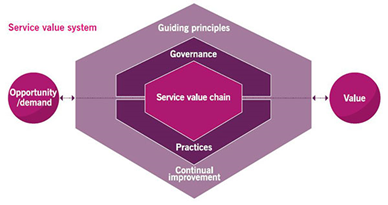Introduction to ITIL® 4 Key Concepts
In this webinar, we will provide an overview of the key concepts of the ITIL 4 Framework. We will discuss the major differences between ITIL V3 and ITIL 4, and provide an overview of the ‘new’ concepts that have been added to the new version:
1. Key Concepts of Creating Value through Services
Information technology is the heartbeat of every organization. It enables government missions, connects employees and constituents, and facilitates efficient operations across the enterprise. However, IT is also in a constant state of change. On one hand, that means we gain access to rapidly evolving features and can continuously improve the services we deliver. On the other hand, it means that IT professionals—and organizations as a whole—can quickly be left behind if they do not keep pace. One way to alleviate this challenge is proper management.
ITIL® has become the most widely accepted framework for IT Service Management (ITSM) in the U.S. It is a systematic approach to ITSM that helps government organizations and businesses manage risk, strengthen customer relationships, establish cost-effective practices, and build stable IT environments. ITIL allows for growth, scale, and change—three vitally important elements for agencies of any size. In the U.S. the ITIL framework has been tried, tested, and proven over the past 20 years, with most government organizations using some form of ITIL-based service management today.
2. The ITIL 4 Service Value System (SVS)
The Service Value System (SVS) is a key component of ITIL 4. It describes how all the components and activities of an organization work together to enable co-creation of value. The SVS has interfaces with other organizations, forming an ecosystem that can also create value for those organizations, their customers, and stakeholders.
The ITIL service value system includes everything needed to create value in the form of services. It encourages you to think about how all the different system components can work together to help co-create value with service consumers.

Figure 1: The Service Value System (reprinted with permission from AXELOS)
At the centre of the service value system is the service value chain. This describes six activities that work together to take incoming opportunities and demand and create corresponding value. The service provider uses these activities to create and manage products and services that enable value co-creation with service consumers.
The Service Value Chain (SVC) is a flexible operating model for the creation, delivery, and continual improvement of services. The SVC defines six key activities: Plan; Improve; Engage; Design and Transition; Obtain/Build; and Deliver and Support. These activities can be combined in many different sequences, allowing an organization to define several variants of value streams. The flexibility offered by the SVC allows organizations to effectively and efficiently react to changing demands from stakeholders.

Figure 2: The Service Value Chain (reprinted with permission from AXELOS)
3. The four dimensions of Service Management
A holistic approach to ITSM is key in ITIL 4. The four dimensions listed below are critical to the successful facilitation of value for customers and other stakeholders. It is essential that an appropriate amount of focus is given to each of these dimensions to generate balanced and effective value:
- Organizations and People: A culture that supports its objectives; the right level of capacity and competency among its workforce
- Information and Technology: The information, knowledge, and technologies (and tools) required for management of services
- Partners and Suppliers: Relationships with other businesses involved in design, deployment, delivery, support, and continual improvement of services
- Value Streams and Processes: How various parts of the organization work in an integrated and coordinated way is important to enable value creation through products and services

Figure 3: The ITIL 4 Dimensions
4. The ITIL 4 guiding principles
The guiding principles outlined in ITIL 4 are not new to ITIL; however, they are meant to help IT professionals adopt and adapt the framework’s guidance to their own specific needs and circumstances. The key is to see the big picture and “think like a CIO.” These guiding principles help IT professionals define approaches and navigate difficult decisions and should be followed at every stage of service delivery.
New in this ITIL update, is an increased focus on collaboration, automation, and keeping things simple. These seven guiding principles reflect principles commonly found in Agile, DevOps and Lean methodologies.
- Focus on value
- Start where you are
- Progress iteratively with feedback
- Collaborate and promote visibility
- Think and work holistically
- Keep it simple and practical
- Optimize and automate
The webinar will end with a Q&A session, where participants can ask questions about ITIL concepts, the new examination and certification scheme, or any other questions related to Service Management.
If you are interested in IT Service Management and have peaked a curiosity for learning more about the new ITIL 4 Framework, this webinar is the perfect opportunity for you.
